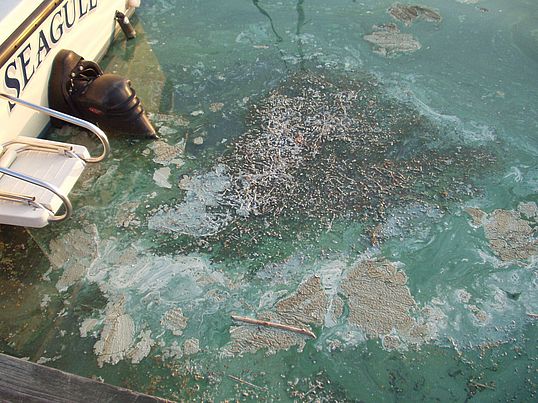The Mutual Suffering of Milfoil and Cyanobacteria

July 2010
Eurasian water milfoil (milfoil) is the bane of many a lake user. This aggressive non-native plant invades lake systems and spreads prolifically, choking out other plants and making swimming, boating, and fishing more difficult. New populations arise from small fragments of plant that become established in a water body. Further fragmentation then expands the population. Between 2005 and milfoil’s first US appearance in 1942 the plant had spread to 45 of the 48 lower United States according to the USGS Non-indigenous aquatic species web page. When it comes to invasive aquatic plants, milfoil is the monster of them all. Yet, in some cases, milfoil can help prevent cyanobacteria blooms, while high densities of cyanobacteria can limit the growth of milfoil.
Milfoil may inhibit the development of cyanobacteria blooms either directly or indirectly. Directly, plants in the milfoil genus (Myriophyllum) produce compounds that appear to suppress cyanobacteria. Indirectly, milfoil populations allow for increased predation on cyanobacteria, preventing blooms from developing.
The direct interaction between milfoil and cyanobacteria is an example of allelopathy. Allelopathy is when an organism produces one or more chemicals, not essential to its own survival, that influence the growth, survival, or reproduction of another organism. The term allelopathy comes from the Greek allele, mutual, and pathy, harm or suffering. There is some debate in the ecological literature about whether the term should be applied only to instances of negative impacts between organisms or whether it might also refer to positive interactions.
Many plants exhibit alleleopathic impacts on their neighbors. Many terrestrial invasive species appear to have allelopathic affects including garlic mustard and spotted knapweed. Black walnut has been the subject of frequent study in many school classrooms. Black walnut leaves, roots, bark, nut hulls, or buds are soaked in water and then the water is used to moisten seeds of some other plant. As a control, the same number of seeds is treated with the same amount of water but no black walnut. Inevitably, more seeds germinate in the control than in the experimental condition. The experiment offers many different tests; for example, are black walnut leaves more allelopathic than bark.
Researchers have isolated at least four different compounds that each can inhibit growth and photosynthesis in the common cyanobacteria Microcystis aeruginosa. Mycrocystis is one of the cyanobacteria known to produce toxins in Lake Champlain. While each chemical was effective in isolation, when combined their impact was more than additive. In a comparison of the impacts of milfoil on different cyanobacteria and algae, researchers observed greater inhibition against Microcystis than against a green alga that does not produce toxins. However, though allelopathy between milfoil and cyanobacteria, as well as the chemicals that cause it, have been observed in lab experiments, it has been more difficult to demonstrate affects in field experiments.
The indirect effects of milfoil on cyanobacteria are not specific to milfoil - other aquatic plants could cause them as well. Small invertebrates are able to hide from fish predators in and among the leaves of whatever aquatic plants are present. As a result, the invertebrates’ population increases. The invertebrates eat cyanobacteria and can sometimes prevent blooms.
However as nutrient concentrations increase, the cyanobacteria grow more quickly and overwhelm their predators. Cyanobacteria can sometimes inhibit the growth of aquatic plants by preventing them from getting enough sunlight. Under these conditions, the direct competition of cyanobacteria with plants can flip the system from one dominated by milfoil, to one dominated by cyanobacteria.
Many of our ideas about interactions between milfoil and cyanobacteria are based upon carefully controlled laboratory experiments. Unfortunately, not all such ideas hold up in the real world and examples of cyanobacteria co-existing with milfoil and other plants can be found in Lake Champlain. Cyanobacteria blooms have plagued St. Albans Bay for decades while extensive milfoil growth has continued despite a sustained harvesting program.
With the shortened summers of the Lake Champlain region we dread any missed opportunity for lake recreation. Both Eurasian water milfoil (milfoil) and cyanobacteria present challenges to our recreating on the lake. The simple fact that milfoil and cyanobacteria challenge each others’ growth and dominance of the aquatic system offers little solace to those seeking to enjoy the lake, but still offers a fascinating reminder of the complexities of the natural world.
Lake Look is a monthly natural history column produced by the Lake Champlain Committee (LCC). Formed in 1963, LCC is the only bi-state organization solely dedicated to protecting Lake Champlain’s health and accessibility. LCC uses science-based advocacy, education, and collaborative action to protect and restore water quality, safeguard natural habitats, foster stewardship, and ensure recreational access.
Get involved by joining LCC using our website secure form (at www.lakechamplaincommittee.org), or mail your contribution (Lake Champlain Committee, 208 Flynn Avenue - BLDG 3 - STUDIO 3-F, Burlington, VT 05401), or contact us at (802) 658-1414, or lcc@lakechamplaincommittee.org for more information.